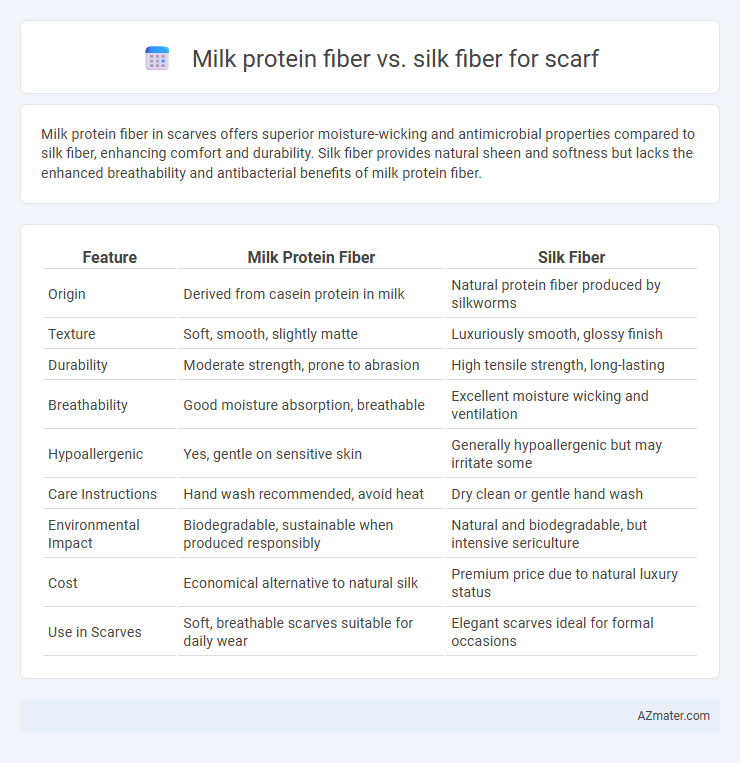Milk protein fiber in scarves offers superior moisture-wicking and antimicrobial properties compared to silk fiber, enhancing comfort and durability. Silk fiber provides natural sheen and softness but lacks the enhanced breathability and antibacterial benefits of milk protein fiber.
Table of Comparison
| Feature | Milk Protein Fiber | Silk Fiber |
|---|---|---|
| Origin | Derived from casein protein in milk | Natural protein fiber produced by silkworms |
| Texture | Soft, smooth, slightly matte | Luxuriously smooth, glossy finish |
| Durability | Moderate strength, prone to abrasion | High tensile strength, long-lasting |
| Breathability | Good moisture absorption, breathable | Excellent moisture wicking and ventilation |
| Hypoallergenic | Yes, gentle on sensitive skin | Generally hypoallergenic but may irritate some |
| Care Instructions | Hand wash recommended, avoid heat | Dry clean or gentle hand wash |
| Environmental Impact | Biodegradable, sustainable when produced responsibly | Natural and biodegradable, but intensive sericulture |
| Cost | Economical alternative to natural silk | Premium price due to natural luxury status |
| Use in Scarves | Soft, breathable scarves suitable for daily wear | Elegant scarves ideal for formal occasions |
Introduction to Milk Protein Fiber and Silk Fiber
Milk protein fiber, derived from casein proteins found in milk, offers softness, breathability, and biodegradability, making it an eco-friendly choice for scarves. Silk fiber, produced by silkworms, is renowned for its luxurious texture, high tensile strength, and natural sheen, providing elegance and durability to scarf fabrics. Both fibers combine comfort and sustainability, but milk protein fiber emphasizes hypoallergenic properties, while silk fiber highlights a smooth, lustrous finish.
Origin and Production Processes
Milk protein fiber originates from casein, a protein derived from milk, which undergoes a chemical process involving purification, mixing with alkali, and extrusion into fibers, making it a sustainable and biodegradable textile option. Silk fiber is produced through the natural process of sericulture, where silkworms spin cocoons composed of fibroin protein, which are then harvested, boiled, and spun into fine, lustrous fibers known for their strength and smooth texture. The production of milk protein fiber relies on biotechnological methods to transform dairy proteins into textile fibers, while silk fiber production depends on traditional, labor-intensive silkworm cultivation and harvesting techniques.
Texture and Feel on the Skin
Milk protein fiber offers a soft, smooth texture with excellent moisture retention, making it gentle and comfortable against sensitive skin. Silk fiber provides a naturally luxurious, glossy surface that feels cool and lightweight, enhancing breathability and reducing friction. While milk protein fiber excels in softness and skin nourishment, silk fiber stands out for its sleek touch and elegant drape in scarves.
Breathability and Moisture Management
Milk protein fiber offers excellent breathability and moisture management due to its porous structure, which allows air circulation and absorbs sweat efficiently, keeping the skin dry and comfortable. Silk fiber also provides good breathability but tends to trap moisture close to the skin, making it less effective at moisture wicking compared to milk protein fiber. For scarves, milk protein fiber delivers superior comfort in warm or humid conditions by maintaining dryness and airflow.
Hypoallergenic and Skin-Friendly Properties
Milk protein fiber offers excellent hypoallergenic qualities by naturally inhibiting bacterial growth, making it ideal for sensitive skin and reducing irritation risks. Silk fiber is also hypoallergenic and skin-friendly, known for its smooth texture that minimizes friction and prevents skin damage or allergic reactions. Both fibers provide breathable, moisture-wicking properties, but milk protein fiber's antimicrobial benefits give it a distinct advantage for those with highly sensitive or allergy-prone skin.
Durability and Longevity Comparison
Milk protein fiber exhibits high tensile strength and excellent elasticity, contributing to durable scarves that resist wear and maintain shape over time. Silk fiber, known for its natural sheen and softness, offers moderate durability but is more prone to abrasion and requires careful handling to preserve longevity. Therefore, milk protein fiber scarves tend to outperform silk in long-term durability, making them ideal for frequent use.
Environmental Impact and Sustainability
Milk protein fiber is a biodegradable material derived from casein, offering low environmental impact through renewable dairy byproduct utilization and reduced chemical processing compared to conventional textiles. Silk fiber, produced by silkworms, involves intensive resource use including water and mulberry cultivation, alongside ethical concerns regarding silkworm harvesting, which impacts its sustainability profile. Milk protein fiber's closed-loop production process and biodegradability contribute to a more eco-friendly and sustainable option for scarf manufacturing versus traditional silk.
Color Retention and Dye Affinity
Milk protein fiber exhibits excellent dye affinity due to its amino acid structure, resulting in vibrant, long-lasting colors on scarves. Silk fiber, composed of fibroin protein, also offers superior color retention but may fade faster under prolonged exposure to sunlight compared to milk protein fiber. Both fibers provide smooth textures, yet milk protein fiber's enhanced colorfastness makes it ideal for scarves requiring durable, vivid hues.
Care Instructions and Maintenance
Milk protein fiber scarves require gentle hand washing in cold water with mild detergent to preserve their softness and avoid damage. Silk fiber scarves should be dry cleaned or hand washed with care, avoiding harsh chemicals and direct sunlight to maintain their sheen and strength. Both fibers benefit from air drying flat to prevent stretching and to prolong the life of the scarf.
Price and Market Availability
Milk protein fiber scarves generally offer a more affordable price point compared to silk fiber scarves, making them an attractive option for budget-conscious consumers. Silk fiber scarves, renowned for their luxury and exceptional softness, tend to command higher prices due to the intricate production process and limited raw material availability. Market availability of milk protein fiber scarves is expanding steadily, supported by synthetic manufacturing advancements, whereas silk fiber scarves remain predominantly sourced from natural silkworm cultivation, leading to more niche market distribution.

Infographic: Milk protein fiber vs Silk fiber for Scarf
 azmater.com
azmater.com